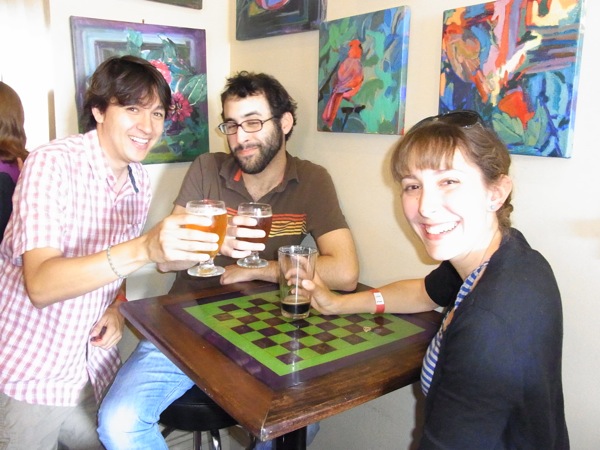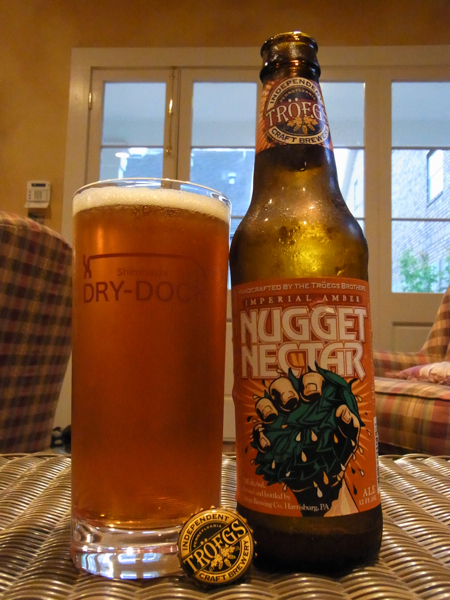Last Saturday I dragged four friends along on a tour of the Baird Beer Taprooms starting in Numazu. We had a miracle start to the trip. I’d planned on catching a 9:41 train from Yokohama, an express out to Atami, but we weren’t able to get through the gates until the minute hand was just about right on the :41, so I just kind of moseyed over to the escalator assuming that we’d end up on the next train and stood on the slow ride up to the platform. When we got to the top the train was still there for some reason, and the door-closing music had only just started playing. I turned to see where the four others were behind me. Teppey was close, but we shared a look – there’s no way we’re getting on this train, right? Slowy Rei, Junichi, and Adam ascended the escalator as the music continued, and we stepped slowly toward the doors as a group. Then suddenly we were on the train and moving to the West at 9:43am:
Baird Beer Taproom Pub Crawl from Daniel Morales on Vimeo.
Numazu Fishmarket Taproom
The original Taproom. The brewery used to be on the first floor until they outgrew it. Great atmosphere, great view of the fish market from the counter along the window. And the pints are all 200 yen cheaper than the other Taprooms – your bonus gift for making the trek out to Shizuoka. The food was very impressive as well. I highly recommend everything we tried, especially the chicken wings which I don’t normally like. I was a bit disappointed there were no exclusive beers available – the first time I visited, there were a couple new selections and lots of older bottles available The beers we had were: Nihon Monogatari Ale, Old World Kolsch, German Summer Ale, Hop Havoc Anniversary Ale, Shimaguni Stout, Numazu Lager, Red Rose Amber Ale. We also picked up bottles of the Wheat King and Single-take Session Ale for the train.
Bashamichi Taproom
The newest and most well-appointed Taproom. Three floors of beer and barbecue goodness in a great part of Yokohama. I have to admit that I have been disappointed by the barbecue; what they offer is good – really good – but when I think barbecue, I think pulled pork, and there was none to be had. I was told, however, that they offer it occasionally. I think the chicken was the most flavorful of all the meat we tried, but I’d like to try the sandwiches at some point. Of all the Taprooms, this is by far the nicest space. There are tables on the roof, which will be amazing when the weather cools down a little, and the second floor is nice and open and surrounded by brick and wood. Free darts! The beers we had were: Bashamichi Ale, Rising Sun Pale Ale, Wheat King.
Harajuku Taproom
The third Taproom, right off of Takeshita-dori – quite a juxtaposition with the wacky Harajuku fashion scene. I love the food at this Taproom. It’s slightly upscale yakitori – everything is nicer than you’d find at a ガード下 location. Don’t miss out on the gyoza or the potato salad, and of course all the chicken is great as well. Also the smallest space of the four Taprooms, so it fills up quickly and seems more full than the other locations. We had: Harajuku Ale, Shimaguni Stout, Single-take Session Ale (I believe…this was the only location where I forgot to film close-ups of the beers themselves, so I’m forced to judge from afar.)
Nakameguro Taproom
The first Tokyo Taproom, second Taproom overall. They’ve done some redecoration since I last visited, and now there the vibe is much comfier – there are sofas in one of the corners and some smaller more intimate tables. The food is the least remarkable of all the Taprooms – unfortunately Nakameguro Taproom has been the big loser of the expansion (in my opinion). I’d choose Harajuku or Bashamichi over it, partially out of convenience but also because of food selection. Nakameguro does serve imported guest beers at decent prices, which offers a refreshing change, and they also have the very sessionable (3.7% ABV) Nakameguro Bitter on hand pump. We had: Naka-meguro Bitter, Old World Kolsch, Green Flash West Coast IPA, Caldera Amber Ale, Suruga Bay IPA.
Notes:
– Very impressed with the Single-take Session Ale as a new addition to the regular lineup. Great beer. Definitely my go-to Baird Beer.
– I’m disappointed we weren’t able to go (for Seishun 18 Kippu reasons) a few weeks earlier when the Cool Breeze Summer Pils was on. Nice beer. Also disappointed that the Sayuri Saison wasn’t available, although I managed a pint at Ushitora’s third anniversary.
– Other Baird Beers I miss: rauchbier he made back in fall of 2008 and the strawberry something in the summer of 2008. I haven’t seen either since, and they were nice. Don’t remember anything specific about the rauch, but it’s always nice to see that style. Hard to compete with Fujizakura, though. And the strawberry beer had this weird metallic aftertaste…not unpleasant after the first few sips…which I hope sounds like a compliment.
– I feel like Baird has done impressive expansion, but I’d like to see the beers available in more grocery stores and other easy-access locations. I guess this is asking the impossible, though: the latest macrobeer craze is beer that can be served on ice. Boo.
































